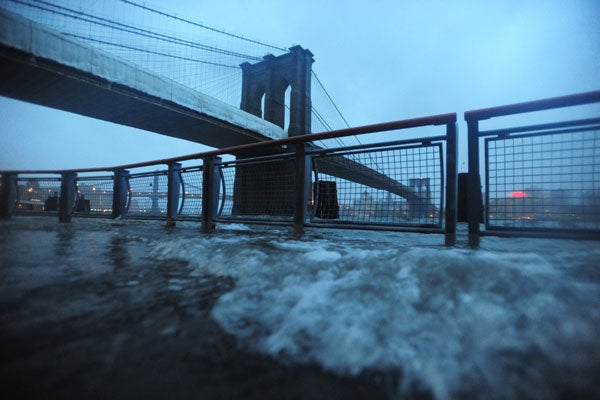In a shameless attempt to politicize Hurricane Sandy, The New York Times rushed out an editorial, “A Big Storm Requires Big Government,” attacking conservatives for advocating a rebalancing of disaster response responsibilities.
The Times says the Federal Emergency Management Agency (FEMA) “was put back in working order by President Obama, but ideology still blinds Republicans to its value. Many don’t like the idea of free aid for poor people, or they think people should pay for their bad decisions, which this week includes living on the East Coast.” That statement is, pardon my French, horse manure.
The Times isn’t the only entity on the left politicizing Hurricane Sandy. Late last night, a friend on the left emailed me asking: “Not sure if you’re watching the news right now but, totally off the record, wondering if you still think the federal government shouldn’t be involved in disaster relief?”
My response (totally on the record) was: “I’ve NEVER said that. What I’ve said consistently is that FEMA/federal government should be reserved for truly catastrophic events like Sandy, Katrina, Northridge, 9/11, etc. FEMA/federal government should not be involved in routine disasters that states/locals have dealt with throughout most of American history. Otherwise, states like Ohio and its taxpayers subsidize tornadoes in Oklahoma or fires in Colorado or floods in Iowa. Ohio is the 7th largest state, so it funds FEMA more than smaller states, yet Ohio typically gets one, maybe two FEMA declarations per year, making Ohio a net loser when FEMA nationalizes smaller-scale events.”
No conservative I know wants to eliminate FEMA or the federal role in disaster response and recovery. The fact is, conservatives have been consistently advocating for the decentralization of those functions for routine natural disasters to states and localities to ensure that FEMA is prepared to deal with truly catastrophic events that hit America—like Hurricane Sandy. See here, here, and here.
The reality is that since 1993, FEMA has nationalized more and more disasters that were historically handled and paid for entirely by states and localities (See CHART here). Disasters such as tornadoes, fires, floods, snowstorms, severe storms, and other small-scale events have little to no regional or national impact and, therefore, no justification for federal involvement.
As we’ve noted, by nationalizing routine disasters, FEMA’s resources—especially staff time and funding—are stretched thin on events that clearly fall outside of the Robert T. Stafford Disaster Relief and Emergency Assistance Act’s mandate that FEMA get involved when the disaster is of such severity and magnitude that it overwhelms state and local resources. Very few natural disasters that have received FEMA declarations since 1993 truly meet that definition.
As FEMA is burdened by administering more than 100 new declarations per year, it doesn’t have time or money to focus on being prepared for catastrophic events, which is why seven years after Hurricane Katrina, FEMA still lacks key capabilities, according to the Government Accountability Office. At the same time, while FEMA nationalizes routine natural disasters and shifts the costs of those events from the states in which those events occur to the other 49 states, states have defunded emergency management. This approach to natural disasters makes no sense.
The federal government cannot do everything or be everywhere. By properly delineating roles and responsibilities, we can make sure that FEMA is prepared for the big events like Hurricane Sandy and gets states back in charge of dealing with and paying for the routine natural disasters that occur in their jurisdictions year after year. Big storms do require big government, but little storms don’t. Knowing the difference is the key to getting out of the fiscal mess we are presently in.





















